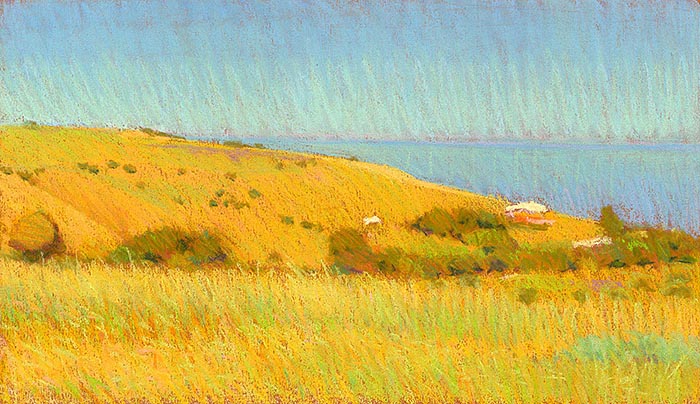
Colours and Tones of Sunlit Scenes - page 1 (of 27) |
Return to Gallery 4 Overview page

“View of Hallett Cove in the Morning”
"Recording the Colours and Tones of Sunlit Scenes" is one of the main themes of the artwork I have produced over many years. It is a theme that I enjoy undertaking, especially when I am working outside, directly from sunlit scenes. This display is a small selection of my better paintings and pastels that are based on recording the colours and tones of sunlit scenes. The basic concept is a very simple one - I take my art materials outside and work directly from scenes lit by sunlight. It is fundamentally a very direct way of me interacting with the world I have found around me. Such pieces are in many ways similar to the work of the "French Impressionists" in principle. The French Impressionists took transportable paints outdoors to paint scenes using the colours that were observed directly from real outdoor scenes. This display has pieces that were produced at a range of places, and at different times in the day, from just after sunrise, to after sunset. They were all produced on-site, directly from the real world. The last page is a menu of similarly produced pieces from the permanent galleries. There are quite a few pieces there, because, as mentioned earlier, "Recording the Colours and Tones of Sunlit Scenes" is one of my main themes. |

|
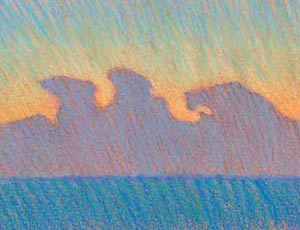
|
|
1. Field of Yellow Flowers |
2. Cloud Shapes at Sunset |
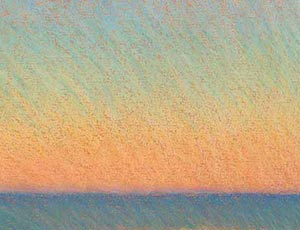
|
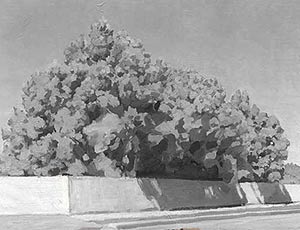
|
|
3. Soft Colours in the Sky |
4. Tamarisks in Early Afternoon Sunlight |
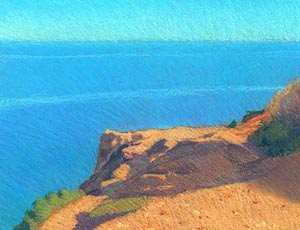
|
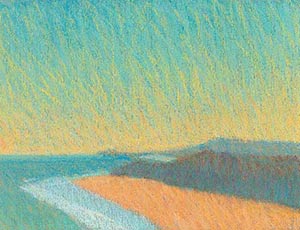
|
|
5. View from the Top Path |
6. Towards the Beach from Witton Bluff, in the Morning |
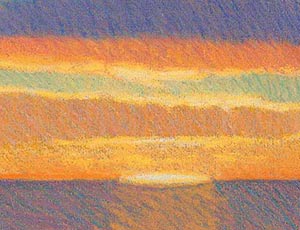
|

|
|
7. Sunset with Wide Cloud Bands |
8. Middle Headland, Witton Bluff |
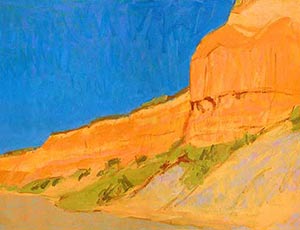
|

|
|
9. Cliffs Leading to Witton Bluff |
10. Looking North Along Glenelg Beach, Early Morning |
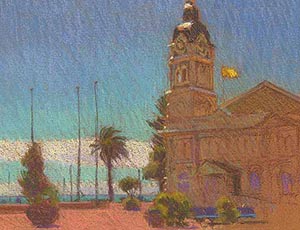
|

|
|
11. Looking Out Across Moseley Square - Windy Afternoon |
12. View of Hallett Cove in the Morning |

|
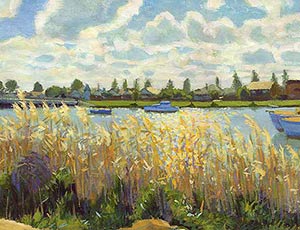
|
|
13. Sunny View from under the Concrete Pathway |
14. Grasses on the Banks of the Patawalonga |
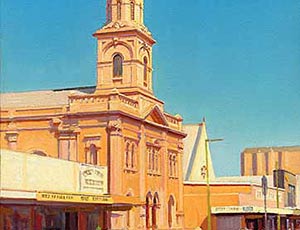
|
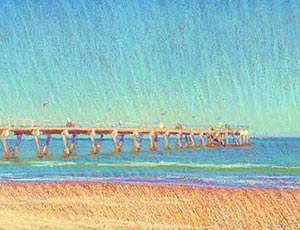
|
|
15. Sunlit Church, Glenelg |
16. Glenelg Jetty in Morning Sunlight |

|
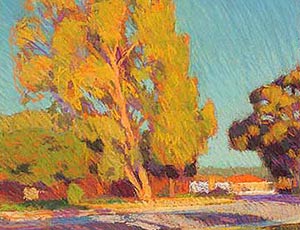
|
|
17. Tamarisks with Distant View of Buildings |
18. Old Tamarisk Pines in Afternoon Sunlight |
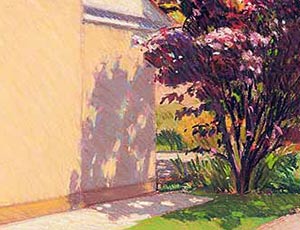
|
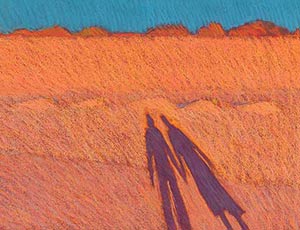
|
|
19. Our Prunus in the Sun |
20. Shadows on the Beach |

|
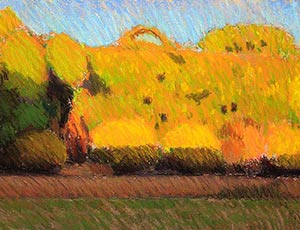
|
|
21. Looking Down South in the Sun |
22. Late Afternoon Sunlight on Our Backyard |
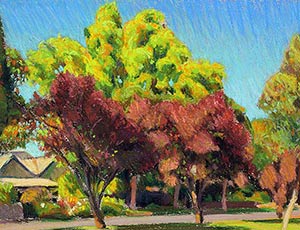
|
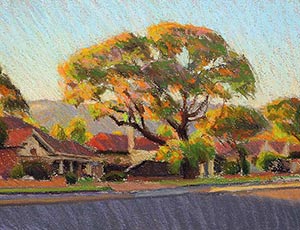
|
|
23. On the Edge of Austral Park, Linden Park |
24. Cedar Tree in Flower, Portrush Road |
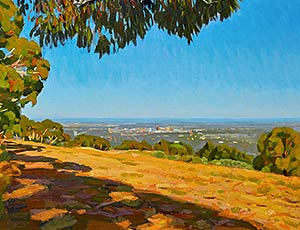
|

|
|
25. View from the Top of the Hill |
Some other pieces from my permanent galleries that are based on recording the colours and tones of sunlit scenes |
Some Aspects/Considerations of Doing this Type of Artwork Many years ago, when I first worked very successfully as a graphic artist/designer, and produced commercial artwork for other people, I eventually started to think that I'd much prefer to be using my artistic skills and understanding for my own ideas, rather than for other people's ideas. But what were my ideas? What things did I think were worthwhile? Well, one thing I feel is very worthwhile is to try to record the real colours and tones of sunlit scenes that I experience. Looking at the world around me lit up with sunlight is something that feels very special. Even without the sun actually out, seeing the world in overcast light is also worthwhile. But when the sun is out, the light is just magic! It's an incredibly beautiful world we live in, surrounded by life, surrounded by air, and water, and soil, and sunlight. It's about feeling a connection with the real world, about studying the complex mix of phenomena that make up the various scenes we see, and about asking questions about the nature of the world we find ourselves living in. Sunlight is a very relevant subject. It is the main light that we see local scenes with. Sunlight also drives just about 99.9999% of all life on this planet. Living organisms classified as 'animals' (including human beings) live by eating other animals and plants. Ultimately, all animals larger than a single cell rely on 'plants' for their continued survival. Plants have the incredible ability to create food from photosynthesis, using sunlight, water and carbon dioxide. Plants and sea plankton that are capable of producing their food from sunlight lie on the bottom of the 'food chain' for almost all other life forms on our planet. Plants using photosynthesis are also responsible for much of the oxygen and nitrogen content in our atmosphere. In this way, the sun has driven, and continues to drive just about all life on this planet, including us. There is a sense of scientific investigation in trying to capture the colours and tones actually experienced. The range of tone and colour experienced in reality is much greater than the range of tone and colour available within paint pigments. Some light outside is so bright it can hurt our eyes to view it for longer than a fraction of a second. There are no paint pigments that are similarly strong. To record what is being experienced, one must synthesize an approximation that 'feels' like it is capturing the essential relationships experienced. I try a certain combination of colours and feel if it is 'accurate' compared with the relationships in the real world. If it is close, I move on to other relationships. If it is not close, I formulate a hypothesis to work out how I can modify what I have, so that I might get a closer result (e.g. add more yellow, or add more red, or tone back the saturation of colour, etc.). I try each hypothesis, and then assess the results. Slowly and methodically, I can build up the accuracy of the scene experienced in front of me. The big trick here though is that when one works outside, directly from sunlit scenes, one has to work extremely quickly to capture as much as possible before the scene changes too much. When I work outside directly from real scenes, I am constantly aware that 'recording the relationships of colours and tones in the world' is an extremely subtle process - and that there are constantly changing colours and tones being seen. The sun's position in our sky changes slowly, but persistently. Shadows change quite quickly. Many things affect the quality of the air, the colours seen in the sky, and the colours seen in objects on the ground. Photographs can capture such scenes reasonably well, but have a number of problems: One big problem is that the film or digital sensor captures the scenes differently to human eyes. The relationships of colours captured in photographs are often quite different to what I have found from recording directly from the scenes in front of me. Another problem is that photographs don't contain the level of deliberate manual construction of paintings and drawings. To produce a painting of such a scene, the artist has had to think and decide about every brush stroke, every mixed colour, etc. This can make a painting or a drawing a more compelling image than a photograph (but not always). One final aspect I wish to try to explain is that many of the scenes actually chosen for producing artwork, were chosen largely out of convenience. When working outside, there are many things that can make producing artwork out there extremely difficult: the changing weather, the changing light during different times of the day, people who may want to prevent you from doing something meaningful in public, or people who want to spend a lot of time watching you and/or talking with you because they would like to do something similar, dogs that may not want you around, wildlife that may not want you around, strong wind, rain, exposure to the sun, having to contend with a wide range of possible insect interventions, having strong light in your eyes, needing to go to the toilet without having a toilet handy, having unknown noises from behind, etc. However, being outside, surrounded by an enormous amount of stimulii can be extremely rewarding and powerful. So much so, that I have done most of my artwork outside, directly from the amazing real world encountered by me. |
Return to Gallery 4 Overview page
Colours and Tones of Sunlit Scenes - page 1 (of 27) |